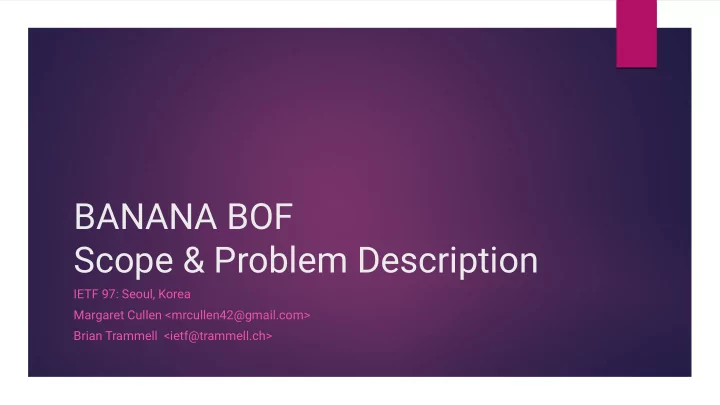

BANANA BOF Scope & Problem Description IETF 97: Seoul, Korea Margaret Cullen <mrcullen42@gmail.com> Brian Trammell <ietf@trammell.ch>
2 BANANA BOF Scope Bandwidth aggregation and failover solutions for multi-access networks where the end-nodes are not multi-access-aware Higher bandwidth (through bandwidth aggregation) Increased reliability (through failover) CPE Internet Content H Source CPE
3 BANANA BOF Scope Bandwidth aggregation and failover solutions for multi-access networks where the end-nodes are not multi-access-aware Higher bandwidth (through bandwidth aggregation) Increased reliability (through failover) Traffjc is sent through default router or the path chosen by Source Address Selection CPE Flow is limited to bandwidth of chosen link Other path is unused Internet Content H Source Flow will not switch to other path if initial path becomes unavailable CPE
4 Three Solution Scenarios Single Operator Multiple access networks provided by a single provider (e.g. DSL & LTE) De-aggregation can occur within the provider network Aggregation Service Multiple access networks from multiple providers (e.g. DSL & Cable) All traffjc from the home is routed/proxied through a de-aggregation service somewhere in the Internet, and then sent to the original destination Edge-to-Edge Multiple access networks from single or multiple providers Traffjc is de-aggregated by multi-access-aware hardware at the remote edge
5 Single-Operator Scenario Home ISP Link 1 Internet Content CPE Source H Link 2
6 Single-Operator Scenario Home ISP Link 1 Internet Content CPE DA Source H Link 2
7 Aggregation Service Scenario Home CPE Internet Content H Source CPE
8 Aggregation Service Scenario Home CPE Internet Content DA AG Source H CPE NAT or Session Termination
9 Edge-to-Edge Scenario Content Provider Home CPE Internet CPE Content H Source CPE
10 Edge-to-Edge Scenario Content Provider Home CPE CPE Internet Content AG /DA Source H CPE
11 Solution Proposals GRE Tunnel Bonding https://datatracker.ietf.org/doc/draft-zhang-gre-tunnel-bonding Current draft assumes Single Operator scenario, could be easily adapted to Aggregation Service scenario Traffjc is shared on a per-packet basis and tunneled to the de-aggregation point in GRE Tunnels. MPTCP Proxy Solution(s) https://datatracker.ietf.org/doc/draft-boucadair-mptcp-plain-mode/ , https://datatracker.ietf.org/doc/draft-peirens-mptcp-transparent/ & other work Current work applies to Single Operator or Aggregation Service scenarios Simple case is TCP-only, work is underway on support for UDP – multiple options being explored
12 Solution Proposals (2) Multipath Bonding at Layer 3 https://irtf.org/anrw/2016/anrw16-fjnal21.pdf Edge-to-edge solution, but incomplete (discovery, security) Output of the Applied NW Research group of the IRTF UDP-only solution, would need work to pair with a TCP solution like MPTCP Proxy MAG Multipath Binding Option https://datatracker.ietf.org/doc/draft-ietf-dmm-mag-multihoming-02 Mobile IP-based solution, work being done in DMM WG Scenario would depend on the topology of the MIP network
13 Solution Proposals (3) Bonding Solution for Hybrid Access https://datatracker.ietf.org/doc/draft-muley-network-based-bonding-hybrid-access/ 3GPP-specifjc solution for Single-Operator scenario
14 High-Level Challenges Performance (only do aggregation if it increases app-level throughput, bottleneck discovery, fmow control to avoid buffer bloat or congestion) Small number of fmows (makes fmow-based load sharing ineffective, do not want high-bandwidth fmows constrained to a single link) Bypass requirement (some traffjc is required by law, regulations or contracts to take a particular path) Tunnel issues: packet reordering, MTU issues, etc. Proxy issues: encrypted traffjc, side-effects of session termination, etc.
15 High-Level Challenges (2) Provisioning/confjguration/discovery (multi-access network details, de- aggregation point, credentials, etc.) Reverse routing (operator controlled? IP address translation? transport-layer session termination?) TCP-only vs. TCP/UDP – bulk of traffjc is TCP now, but will that remain constant as QUIC is deployed more widely? what about UDP failover? Security! -- Must not become a vehicle for MITM attacks! Transition Strategy – how does this mechanism interact with end-to-end MPTCP? with end-nodes that are multi-access aware? etc.
16 Clarifying Questions? ?
Recommend
More recommend